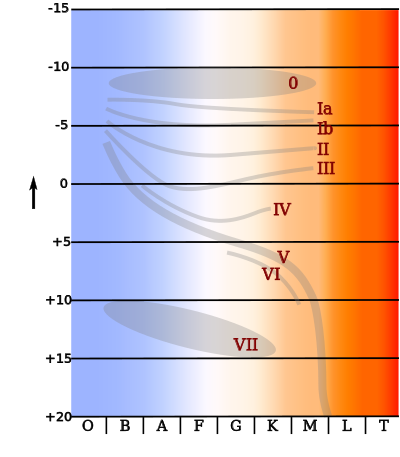عملاق عظيم أزرق
عملاق عظيم أزرق Blue supergiant star هو نجم ساطع ساخن، يشار إليه علمياً بالتوصيف OB supergiants. They have luminosity class I and spectral class B9 or earlier.[1]
Blue supergiants (BSGs) are found towards the top left of the Hertzsprung–Russell diagram to the right of the main sequence. They are larger than the Sun but smaller than a red supergiant, with surface temperatures of 10,000–50,000 K and luminosities from about 10,000 to a million times the Sun.
. . . . . . . . . . . . . . . . . . . . . . . . . . . . . . . . . . . . . . . . . . . . . . . . . . . . . . . . . . . . . . . . . . . . . . . . . . . . . . . . . . . . . . . . . . . . . . . . . . . . . . . . . . . . . . . . . . . . . . . . . . . . . . . . . . . . . . . . . . . . . . . . . . . . . . . . . . . . . . . . . . . . . . . .
التشكل
Supergiants are evolved high-mass stars, larger and more luminous than main-sequence stars. O class and early B class stars with initial masses around 10-300 M☉ evolve away from the main sequence in just a few million years as their hydrogen is consumed and heavy elements start to appear near the surface of the star. These stars usually become blue supergiants, although it is possible that some of them evolve directly to Wolf–Rayet stars.[2] Expansion into the supergiant stage occurs when hydrogen in the core of the star is depleted and hydrogen shell burning starts, but it may also be caused as heavy elements are dredged up to the surface by convection and mass loss due to radiation pressure increase.[3]
السمات
أمثلة
- MACS J1149 Lensed Star 1 (or Icarus) – most distant individual star detected
- Rigel (β Orionis), a blue-white (B-type) supergiant
- UW Canis Majoris (UW CMa), a blue-white (O-type) supergiant
- Zeta Puppis (Naos), a blue (O-type) supergiant
الهامش
- ^ Massey, P.; Puls, J.; Pauldrach, A. W. A.; Bresolin, F.; Kudritzki, R. P.; Simon, T. (2005). "The Physical Properties and Effective Temperature Scale of O‐Type Stars as a Function of Metallicity. II. Analysis of 20 More Magellanic Cloud Stars and Results from the Complete Sample". The Astrophysical Journal. 627: 477. arXiv:astro-ph/0503464. Bibcode:2005ApJ...627..477M. doi:10.1086/430417.
- ^ Georges Meynet; Cyril Georgy; Raphael Hirschi; Andre Maeder; Phil Massey; Norbert Przybilla; Fernanda Nieva (12–16 July 2010). G. Rauw; M. De Becker; Y. Nazé; J.-M. Vreux; P. Williams (eds.). "Red Supergiants, Luminous Blue Variables and Wolf-Rayet stars: The single massive star perspective". Societe Royale des Sciences de Liege, Bulletin, (Proceedings of the 39th Liege Astrophysical Colloquium. Liège (published 2011). 80 (39): 266–278. arXiv:1101.5873. Bibcode:2011BSRSL..80..266M.
- ^ Eggenberger, P.; Meynet, G.; Maeder, A. (2009). "Modelling massive stars with mass loss". Communications in Asteroseismology. 158: 87. Bibcode:2009CoAst.158...87E.
